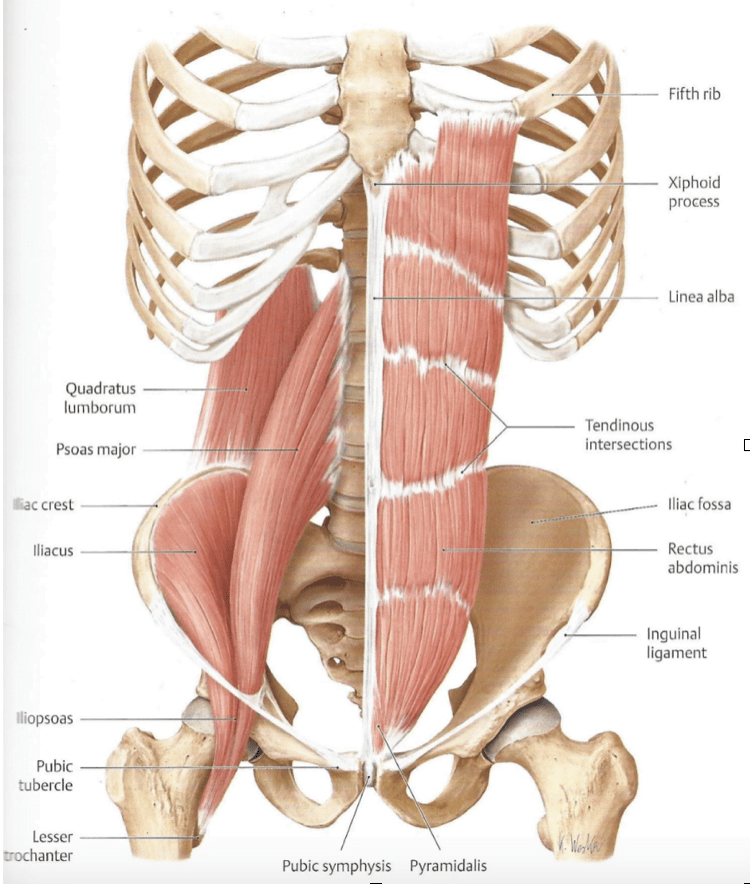
YOUR FITNESS BLOG
How Your Core Can Protect Your Back
Introduction
Core strengthening has become an area of increasing interest in fitness and rehabilitation circles because of the rising rate of exercise-related low back injuries. In fitness, we emphasise abdominal exercises to achieve a defined or toned stomach, but with little or any consideration of spinal stability. Yet, the core is a major stabiliser of the body and spine during movement and particularly during dynamic resistnce exercises like squats, deadlifts and direct abdominal work.
Anatomy Of The Core
The abdominals are just one component that makes up our core. Additional structures that compose the core include the lumbar spine, back extensors, quadratus lumborum (side flexing muscle) and multi-joint muscles, namely, latissimus dorsi and psoas (primary hip flexor) that pass through the core, linking it to the pelvis, legs, shoulders, and arms.
If we consider the traditional approach to core strengthening, using a sit-up either on the floor or over gym ball, the repetitive movement here is spinal flexion. Evidence clearly shows that the damaging mechanism leading to disc herniation, or prolapse of the spine, is repeated lumbar flexion requiring only very modest concomitant compressive spinal loads. Therefore, sit-ups or curl-ups only serve to increase compressive forces on the spine replicating back injury mechanics.
In an effort to protect our back during exercise, we must consider the muscles that function to protect the spine. In particular, the transverse abdominis (TVA), a deep abdominal muscle, has received much attention with respect to spinal stability because of its orientation running horizontally around the abdomen. There are many trainers and therapists that advocate TVA activation to stabilize the spine, because research shows that together with the internal and external oblique the TVA increases intra-abdominal pressure when the abdomen is drawn inward or “hollowed,” therefore imparting functional stability of the lower back.
Abdominal Bracing Versus Hollowing
Instead, Dr. Stuart McGill, a leading spine biomechanist suggests that pulling or hollowing in the abdominals to “activate the transverse abdominis” to enhance spinal stability fails to actually stabilize the spine at all and that trainers who focus on this approach are misdirected. McGill (2009) found that abdominal hollowing techniques reduces the potential energy of the spinal column causing the spine to fail at lower applied loads. An additional reason is that the TVA fails to target the major stabilizers of the spine like the quadratus lumborum that functions to laterally flex the back.
Maintaining a neutral or “stiff” spine during core training has been advocated as the safest and most effective approach to creating spinal stability. In contrast to TVA activation, McGill suggests that abdominal bracing enhances spinal stability. An abdominal brace occurs when there is simultaneous co-contraction of the abdominals, lower back, and buttock muscles. To perform abdominal bracing, the abdominal muscles are contracted (as if getting punched in the stomach) as well as the buttocks, which should generate simultaneous contraction of the lower back muscles. Another way to feel this contraction is to cough or simulate blowing out a candle.
Enhancing Spinal Stability
With an isometric abdominal brace, McGill suggests that all three layers of the abdominal wall (internal and external obliques and transverse abdominis) are co-activated with simultaneous activation of the latissimus dorsi, quadratus lumborum, and the back extensors. Therefore, the entire abdominal wall is activated from all directions as these muscle layers bind together to enhance spinal stiffness and stability.
McGill makes the analogy of a guy-wire system as on a ship mast. Core bracing assists in keeping a wide base to the guy wires and recruits the oblique muscles to create cross-bracing support for spinal stability in all directions. In contrast, McGill suggests that abdominal hollowing to “activate the transverse abdominis” reduces the guy wire base, consequently reducing spinal stability. In support, multiple authors comparing the effects of abdominal hollowing to bracing have found that the hollowing maneuver does not directly enhance spinal stability, whereas abdominal bracing generates torso co-contraction, reduces lumbar displacement, and increases rectus abdominis and internal and external oblique activation.
Summary
The objective of this article is not to be definitive in the argument that abdominal bracing is superior to hollowing for enhancing spinal stability. Certainly, there are counter arguments presented against abdominal bracing. As well, abdominal hollowing to restore TVA activation most definitely has its place. Rather, this article serves to shed light on an alternative technique to spinal stability, while hopefully bringing more awareness to the importance of spinal stability during exercise.
For more information on our personal training services please click here to read more.
References:
1. Juker, D., McGill, S.M., Kropf, P., and Steffen, T. (1998) Quantitative intramuscular myoelectric activity of lumbar portions of psoas and the abdominal wall during a wide variety of tasks. Medical Science Sports & Exercise. 30: 301–310.
2. Koh, H.W., Cho, S.H., & Kim, C.Y. (2014). Comparison of the Effects of Hollowing and Bracing Exercises on Cross-sectional Areas of Abdominal Muscles in Middle-aged Women. Journal of Physical Therapy Science, 26(2), 295–299. doi:10.1589/jpts.26.295
3. McGill, S.M. (2010). Core Training: Evidence Translating to Better Performance and Injury Prevention. Journal of Strength and Conditioning, June 32(3), 33-46.
4. McGill, S.M. (2009). Ultimate Back Fitness and Performance (4th ed). Waterloo, Canada: Backfitpro Inc, 2009. pp. 124–125.
5. McGill, S.M. (2007). Low Back Disorders. Evidence-Based Prevention and Rehabilitation. Human Kinetics, Champaign, Illinois.
6. Vera-Garcia, F.J., Elvira, J. L., Brown, S.H., and McGill, S.M. (2007). Effects of abdominal stabilization maneuvers on the control of spine motion and stability against sudden trunk perturbations. Journal of Electromyography Kinesiology. Oct;17(5):556-67.

Did you find this content valuable?
Add yourself to our community to be notified of future content.


